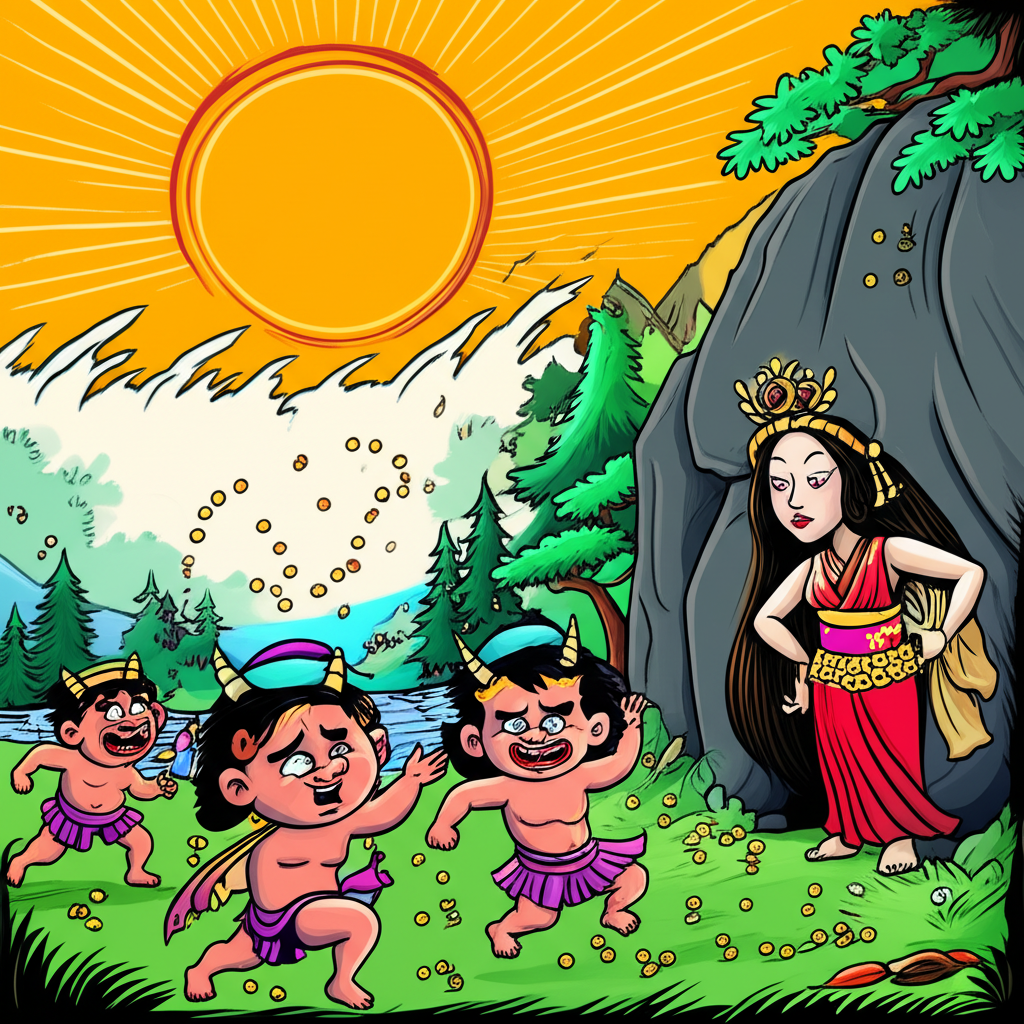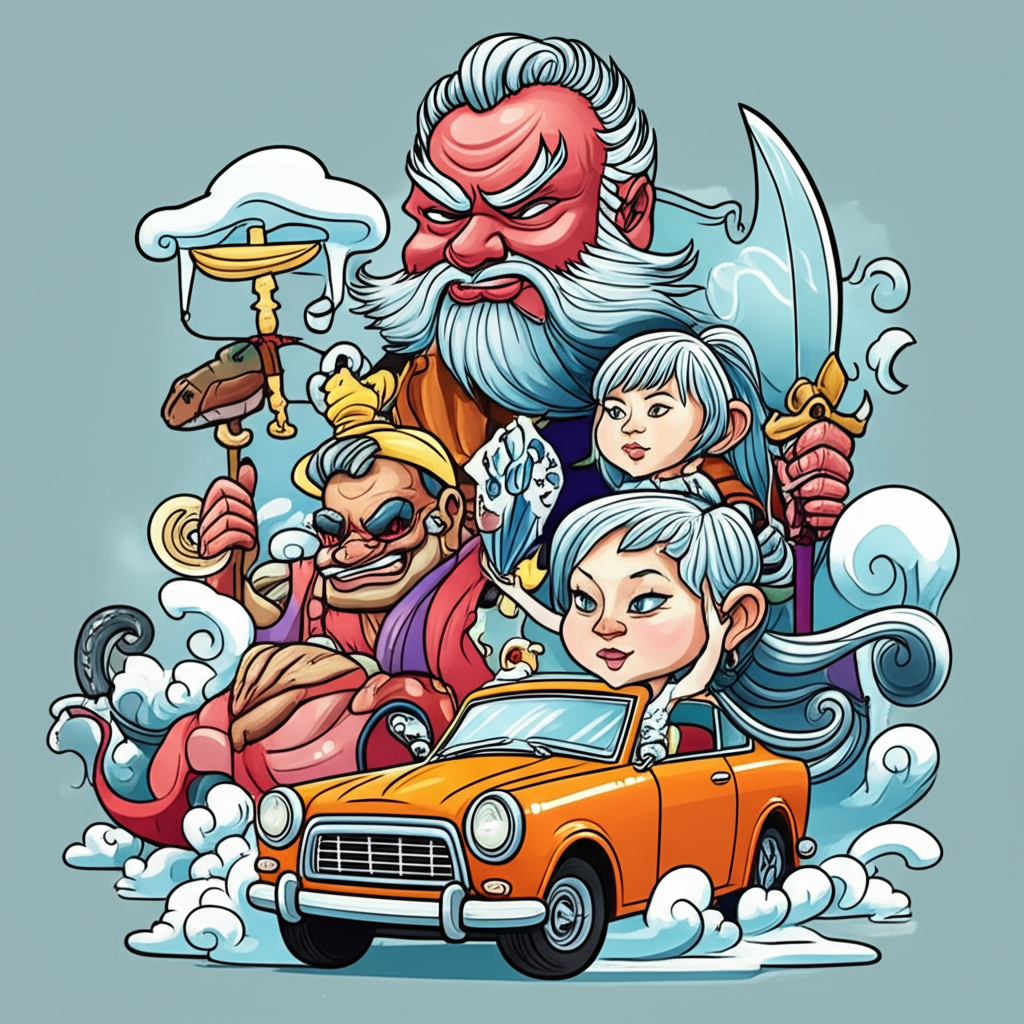
The Light in the Cave: Amaterasu and the Symbolic Journey of Setsubun
Disclaimer: The following article explores a story from Japanese mythology and folklore. This narrative is a traditional tale created by ancient people to explain their world and is presented for cultural, historical, and educational understanding. It is not real and is not intended to be believed, worshipped, or practiced.
Introduction
From the verdant, mist-shrouded islands of ancient Japan comes a foundational story woven into the cultural fabric of the nation. It is a tale from the Shinto tradition, an ancient belief system deeply connected to nature, spirits, and the cycles of the earth. This is the story of Amaterasu Omikami, the personification of the sun, and her retreat from the world. It is a narrative told by ancient people not as a literal history, but as a profound allegory to explain the terrifying darkness of winter and celebrate the joyous return of spring—a cycle symbolically re-enacted in the modern Japanese festival of Setsubun.
Origins and Cultural Background
To understand this myth, one must imagine the world of ancient Japan, likely during the Yayoi or Kofun periods (c. 300 BCE – 538 CE). This was a society intimately tied to the land. Life was governed by the rhythm of the seasons: the planting of rice in the spring, its cultivation in the summer, the harvest in the autumn, and the struggle for survival through the cold, dark winter. For these people, the world was alive with kami—spirits or essences that inhabited everything from mountains and rivers to trees and the wind. This animistic worldview did not seek to scientifically explain phenomena but to understand them through relationships and stories. The sun was not merely a star; it was the ultimate source of warmth, life, and order. Its disappearance, whether during an eclipse or the long nights of winter, was a source of profound existential fear. The stories recorded in texts like the Kojiki (Record of Ancient Matters) and the Nihon Shoki (The Chronicles of Japan) were a way to give meaning to this cosmic drama.
Character Description: The Sun and the Storm
At the heart of this story is Amaterasu Omikami. In the mythology, she is not depicted as a human queen with supernatural powers, but rather as the very embodiment of the sun. She represents order, purity, light, and the life-giving energy that sustains the world. Her symbolic attributes include the Yata-no-Kagami (the eight-span mirror), a symbol of wisdom and truth, and her role as the weaver of the celestial garments, representing the orderly pattern of the cosmos.
Her antithesis is her brother, Susanoo-no-Mikoto, the kami of the sea and storms. Where Amaterasu represents order, Susanoo embodies chaos. He is wild, unpredictable, and destructive, like a typhoon that ravages the coast or a summer storm that floods the rice paddies. His actions are not necessarily born of pure evil, but of a tempestuous and untamed nature. The tension between these two figures represents the eternal struggle between cosmic order and the disruptive forces of the natural world.
The Main Story: When the Sun Hid from the World
The narrative begins with Susanoo’s destructive behavior. Cast out from the heavens, he ascends to bid his sister Amaterasu farewell. His arrival, however, is marked by chaos. He rampages through the celestial plains, destroying the intricate irrigation channels of the rice fields, defiling the sacred hall, and, in a final, horrific act, flinging a flayed heavenly horse into Amaterasu’s sacred weaving hall, causing the death of one of her attendants.
Overwhelmed by grief and fear at her brother’s chaotic violence, Amaterasu did the unthinkable. She retreated from the world, sealing herself inside the Ama-no-Iwato, the Heavenly Rock Cave. As she vanished, so did the light. The world was plunged into an unending night. The vibrant green of the rice paddies faded to a sickly brown, the crops withered, and a chilling cold settled over the land. The world fell into disarray as malevolent spirits, empowered by the darkness, began to roam free. The eight million kami of the heavens gathered in a panic, their world teetering on the brink of collapse.
Brute force could not move the boulder sealing the cave. The kami realized they needed a different approach: one of cleverness, community, and joy. They devised a plan. They gathered the long-crowing roosters, whose calls were thought to herald the dawn. They forged the beautiful Yata-no-Kagami mirror and the Yasakani-no-Magatama jewel, placing them on a sacred sakaki tree before the cave.
Then, the kami of dawn and mirth, Ame-no-Uzume, began to perform. She overturned a tub, stamping on it with such fervor that her feet seemed to drum up the heartbeat of the world. She began a wild, comical, and unrestrained dance. The performance was so joyous and absurd that the assembled kami erupted in thunderous laughter.
Inside the cave, Amaterasu heard the commotion. Confused, she wondered how the world could be so full of celebration when it was supposed to be shrouded in darkness and her sorrow. Her curiosity overcame her grief. She pushed the boulder aside just a crack and called out, "I thought the world was dark without me. Why is there such laughter?"
Ame-no-Uzume replied, "We rejoice because we have found a being more radiant than you!" As she spoke, another kami held up the Yata-no-Kagami mirror. Amaterasu peered out and saw her own brilliant reflection, a light so powerful she momentarily forgot it was her own. Stunned by the sight, she leaned further out of the cave. In that instant, the kami of immense strength, Ame-no-Tajikarao, who had been hiding beside the entrance, seized her hand and pulled her out into the open. The world was instantly flooded with her light. The darkness receded, the chill broke, and life began to return to the land. The long winter of the spirit was over.
Symbolism and Meaning
For the ancient people who told this story, its meaning was deeply tied to their experience of the world. The tale is a powerful allegory for the changing of the seasons. Amaterasu’s retreat into the cave represents the weakening of the sun in winter, a time of darkness, cold, and death. Susanoo’s chaos symbolizes the destructive storms and unpredictability of nature that could lead to famine and hardship.
The collective action of the kami represents the importance of human community and ritual. It suggests that during the darkest times, it is not force but cooperation, cleverness, and even joy that can bring back the light. Ame-no-Uzume’s dance is particularly symbolic, representing the power of art, laughter, and celebration to dispel despair and call forth hope. The story served as a comforting assurance: even in the deepest, longest night, the light will eventually return.
This narrative forms the symbolic foundation for the festival of Setsubun, which literally means "seasonal division." Held on the day before the start of spring in the old Japanese calendar, Setsubun is a ritual for purging the bad luck and malevolent forces of the previous year and welcoming the good fortune of the new one. The act of mamemaki (bean-throwing), where people throw roasted soybeans out their doors while shouting "Oni wa soto! Fuku wa uchi!" ("Demons out! Fortune in!"), is a direct echo of the kami driving away the darkness to welcome back Amaterasu’s light. The oni (demons) are symbolic of the misfortune, illness, and gloom that festered when the sun was hidden away.
Modern Perspective
Today, the story of Amaterasu and the traditions of Setsubun continue to be a vibrant part of Japanese culture, though their interpretation has evolved. Amaterasu is a recurring figure in modern media, often reimagined in literature, anime, manga, and video games. A prominent example is the critically acclaimed video game Ōkami, where the player controls Amaterasu in the form of a white wolf, tasked with restoring color and life to a cursed land. In the popular anime Naruto, "Amaterasu" is the name of a powerful and inextinguishable black flame, borrowing the name’s association with the sun’s immense power.
Setsubun itself is now a beloved cultural event. Families participate in mamemaki, often with a family member playfully wearing an oni mask. The practice of eating a large, uncut sushi roll called ehomaki while facing a specific "lucky" direction has also become a popular modern tradition. These practices are no longer rooted in a genuine fear of a sunless world but have transformed into cherished traditions that connect modern families to their cultural heritage and mark the hopeful transition from winter to spring.
Conclusion
The myth of Amaterasu’s journey into and out of the Heavenly Rock Cave is a timeless piece of cultural storytelling. It is a powerful narrative that reflects the deep connection ancient Japanese people had with the natural world, encapsulating their fears of winter’s darkness and their profound joy at the return of spring’s light. As a cultural story, it offers a window into a worldview where the cosmos was understood through imagination and allegory.
As Muslims, we recognize that only Allah is the true Creator and Sustainer of the universe, the sole source of all light and life, and the one who governs the cycles of day, night, and the seasons.
Nevertheless, by studying such myths, we can appreciate the rich tapestry of human culture. These stories, while not to be believed, demonstrate the universal human impulse to find meaning in the world around us, to overcome fear through community, and to celebrate the enduring hope that even after the longest night, the dawn will always return. They stand as a testament to the power of imagination and the enduring tradition of storytelling that connects us to the past.





